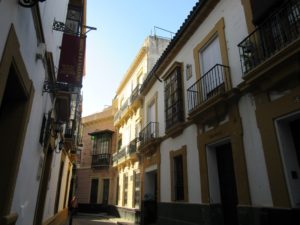You have no items in your cart. Want to get some nice things?
Go shopping
The streets all look the same in Sevilla, but still I was certain there was no way I could ever get lost there. I wandered aimlessly through residential areas, peering into patios to catch a glimpse of the patterned tiles that never seemed to repeat themselves. The streets were void of people, save for an old lady I came across who stared at me as if I was out of my mind for looking into random peoples’ courtyards.
I wondered if people found their ways home based solely on the pattern of the tiles on the patios. It’s a silly idea, but I couldn’t stop myself from imagining a man looking to purchase a new home for him and his bride. He would say: I want a house with yellow and blue tiles. He would be disappointed when his realtor would tell him that the pattern had already been taken by señor so and so. You can’t have a house with the same pattern, the realtor would say. You might mistake another man’s house for your own!
Mind you, that’s just my imagination. The streets have names, as they should, because they all look the same. The names are not unfamiliar to me; they’re almost the same as some of the street names we have back home. My favorite: Calle Mateos Gago. It’s funny only if you speak Filipino, because gago is a word that I used to make fun or scold. But if you’re unfamiliar with Filipino, the name will be of no humorous importance.
I stop walking only to purchase a bottle of water at a café whose name I have now forgotten, but I remember that the bartender was amused at my being there. This one was one of those tourists that are so enamoured with our way of life, he must have thought. I looked around and saw that the café barely had any customers, save an old man reading a newspaper and a group of ladies sat outside. It was siesta time; people were in bed or along the river soaking up as much sun as they could.
I left, a cold bottle of water in my hand, and continued my walk only to stumble upon a small park where children and teenagers were milling around, some on their skateboards, others sitting and chatting on the benches. The shade from the trees was a welcome relief.
I stared up at the bright oranges waiting to be plucked from their branches. I found it odd that the trees were undisturbed by modernity, by paved roads and concrete buildings. I wondered about how old they were. Could I just reach up and pick an orange from its branch? Nobody else was doing it, so I didn’t as well. But coming from a country where trees were cut down to make room for more roads, it was an anomaly to see hundreds of them so undisturbed.
Later on, I stepped into a small bookstore, where the shopkeeper greeted me warmly before returning to his conversation with another customer, an elderly man that looked like he frequented the book shops of Sevilla. Bits of overheard conversation told me that tourists didn’t usually come to this part of the city, that the store had remained untouched by picture-taking visitors. How lovely, I thought, to be in a place so authentically Spanish. The shelves looked like they had seen better days; the books, thick and imposing, seemed to reserve themselves only for the literati. Maybe one day I would be able to read those books.
I found another bookstore a few blocks after the last; tourist guides and maps were on the stands outside. At a shelf near the back, I found a copy of Noli Me Tangere by Jose Rizal in the original Spanish. I asked the owner if there were any more. No, he said. That’s the last one. I smiled. If this was the last, then people were buying it. There was a swelling that happened in my chest then, a sort of pride in the fact that this was a book so deeply rooted in my being Filipino. I placed it back on the shelf, hoping that it would be sold before the end of the day, and walked on.
At some point I ended up on the street I had come from when I began my walk. The advertisement on the corner waiting shed told me I was nearing our hostel. I looked up and saw that the sun was beginning to set, that the clouds were starting to become redder, calmer. By Spanish standards, the day was still young. I checked my watch and saw that it was only six in the evening, but at this point, my memory might have already failed me and I could be remembering things in a sequence that never happened.
Nevertheless, I reached our hostel early in the evening, sat down to rest my tired feet, and deposited the shopping bags I had accumulated in my room. A few hours of solitude, after nearly four weeks of being with 30 other people, was a state I thought I had forgotten about, and it was a more than welcome change of pace. And when they asked me to come with them to the Plaza Mayor, I declined, opting for the more peaceful dinner out with my professors who told me about life in Spain, and who joked that they would leave us for the quieter setting of Sevilla. I couldn’t blame them.
We walked along the Paseo de Cristóbal Colón, stumbling upon a noisy cruise ship that had recently docked, and passing the Torro del Oro, which we stopped to take pictures of. The sky was now a clean sky blue color. We had mojitos at a bar along the paseo, talked about our favorite parts of the tour so far, and fell into a melancholy silence. Melancholy, because we knew our adventures in Spain were just about to come to an end.
My mother once told me that she felt homesick after being in Spain for about three weeks. We were four weeks into the tour at this point – the last leg – and I was still at ease with my having been away for so long. I had three more weeks left in Spain, but no feeling of longing had crept into me just yet. This is how I knew I wasn’t ready to go home; wasn’t ready to say goodbye to the carefree life I had adopted in this country.
In the distance, I saw the torre, true to its name, become almost golden under the light of the fading sun. I knew, then, that this is what I would remember of Seville – tiles with never ending patterns, orange trees that seemed to own the streets, a soft breeze from the Canal de Alfonso XIII, and the golden tower that would, the following day, bid me farewell.

About Anna Nicola Blanco
"The great affair is to move." ―Robert Louis Stevenson Anna Nicola Blanco is set to graduate in May 2017 from the Ateneo de Manila University, where she is studying journalism. She is also taking minor degrees in Spanish and Creative Writing. Her works may be found in HEIGHTS, PLURAL: Prose Journal, MVNDO, Rappler, The Fat Kid Inside, and Mabuhay Magazine.

